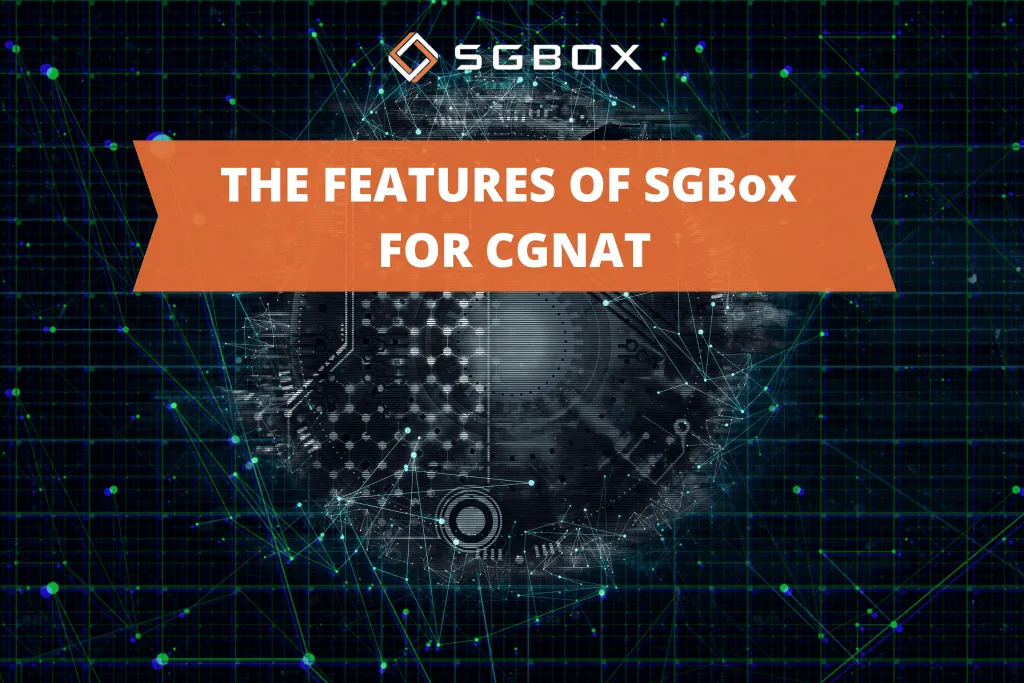SGBox for CGNAT: features and benefits

Understanding Carrier-Grade NAT (CGNAT)
Carrier-Grade NAT (CGNAT) is a large-scale network address translation technology used by Internet Service Providers (ISPs) to manage the scarcity of IPv4 addresses.
It allows multiple customers to share a single public IPv4 address, effectively extending the lifespan of the IPv4 protocol by creating a private network within the ISP’s infrastructure, where each customer’s device is assigned a private IP address.
The CGNAT device then translates these private IP addresses to a limited pool of public IPv4 addresses when connecting to the internet.
Why CGNAT Log Management is essential
Managing CGNAT logs is not just a technical requirement: it’s a critical component of responsible network operation.
The sheer volume of data generated by CGNAT requires a robust and scalable solution for several key reasons:
- Regulatory compliance: many countries have laws that require ISPs to store and provide access to network traffic data for a specific period. This is crucial for law enforcement and legal investigations. Without proper CGNAT logging, it’s impossible to trace user activity back to a specific public IP address and timestamp, leading to compliance failures and potential legal repercussions.
- Problem solving: when customers experience connectivity issues, CGNAT logs are the first place to look. They provide the necessary information to diagnose network problems, identify bottlenecks, and resolve service-related complaints efficiently. By mapping internal IP addresses to their corresponding public IPs and ports, network administrators can pinpoint the source of a problem and quickly restore service.
- Enhanced security: CGNAT logs are vital for network security. They help in identifying and investigating malicious activities such as DDoS attacks, spam campaigns, and other forms of cybercrime. By correlating log data, security teams can trace the origin of an attack back to the specific private IP address on the internal network, enabling them to take appropriate action.
How SGBox manages CGNAT Logs
SGBox offers a comprehensive and efficient solution for CGNAT Log Management, designed to handle the massive data volumes and unique requirements of ISP networks.
- Connection logging: SGBox captures detailed information about every connection, including the source private IP address and port, the translated public IP address and port, the destination IP address and port, and the connection’s timestamp. This data provides a complete record of network activity.
- Mapping and dynamic assignment: the SGBox platform intelligently handles the dynamic nature of CGNAT. It accurately maps the dynamically assigned private IP addresses to the shared public IPs, ensuring that a clear and verifiable link exists between each user and their internet traffic.
- Log collection and analysis: SGBox collects logs from multiple CGNAT sources, centralizing them in a single, scalable repository. Its powerful analytics engine processes this data, enabling quick searches, correlation of events, and generation of reports for compliance and troubleshooting.
- Data Export: the system supports various data export formats, making it easy to share log data with law enforcement agencies or other authorized parties, in compliance with regulatory requirements.
Key advantages of SGBox for CGNAT
SGBox stands out as an ideal solution for CGNAT Log Management due to its focus on performance, efficiency, and cost-effectiveness.
- High-Volume Data Management: built to handle the immense volume of data generated by modern ISP networks, SGBox is a high-performance solution that ensures no data is lost or delayed.
- Efficiency & reduced complexity: the platform simplifies the complex task of log management through an intuitive interface and automated processes, freeing up valuable IT resources.
- Affordable cost: SGBox provides a high-value solution at a competitive price, making it accessible for ISPs of all sizes.
Technical architecture: clustering model
The SGBox technical architecture is built on a clustering model, which provides virtually unlimited data ingestion and management capacity.
This distributed approach ensures scalability and resilience, guaranteeing that the system can grow with your network without performance degradation.
As an EU technology, SGBox ensures data residency and compliance with European data protection regulations.

